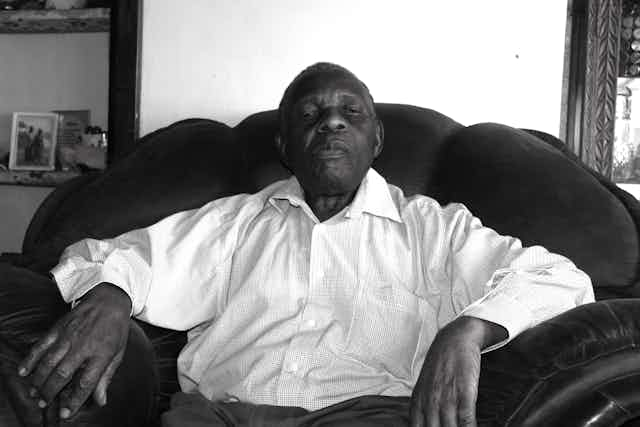John Hlatywayo, who has died at 96, was a great painter, sculptor and mentor. However he is woefully neglected in the art history of Zimbabwe and southern Africa.
Belonging to an early generation of Zimbabwean artists, Hlatywayo was overshadowed by international interest in the nation’s mainstreamed stone sculptors. Yet he was one of Zimbabwe’s most versatile artists. He could work with different media and produce intriguing conceptual pieces. But he was mainly drawn to portraying aspects of people’s daily lives.
Read more: Shepherd Ndudzo's celebrated sculptures tell an untold history of southern African art
He trained in neighbouring South Africa and went on to exhibit his work in Johannesburg, Cape Town, Salisbury (now Harare) and London. His pieces are in the collections of the Wits Art Museum and the National Gallery of Zimbabwe.
In 2018 I had the opportunity to interview Hlatywayo as one of the Black artist-teachers at the centre of my PhD thesis. My thesis tries to broaden Zimbabwe’s modern art canon, arguing for the inclusion of marginalised artist-teachers like Hlatywayo.
A selfless individual, Hlatywayo worked tirelessly to teach and develop art in his community. His story is also important to the region as it represents the transnational sharing of art traditions between South Africa and Zimbabwe.
Schooling
Hlatywayo was born in 1927 at Chikore Mission in the Ndau-speaking Chipinge district of Rhodesia – today Zimbabwe. (Ndau is a Shona dialect spoken in southeastern Zimbabwe.)

At primary school at the Mount Selinda Institute, a US mission school, he took an interest in art classes offered by a US expatriate. As a carpentry and building trainee, he helped the self-sustaining institution with the construction of houses.
South Africa
In 1948 he set off for South Africa. He told me about how migrants were screened by officials at the Musina border post. Under the system implemented by the Witwatersrand Native Labour Association, those who were fit to work in the mines progressed to Johannesburg. The rest were taken to work on the nearby farms.
In Johannesburg he was settled in a compound among other migrant labourers who worked in the mines. Before long, he moved to Pretoria, finding work at a metal smelting plant, doubling as a “teaboy” serving a white manager with whom, he said, he never held a normal conversation.
Back in Johannesburg he teamed up with a cousin to start a carpentry shop. It was there that he met a client who ended up introducing him to celebrated South African artist Cecil Skotnes.
Art school
From 1952 to 1966 Skotnes ran the Polly Street Art Centre, converting the former Adult Non-European Recreation Centre into a place where artists would train and fraternise, regardless of their background in a racially divided South Africa during apartheid.

Art historians note that the teaching at the institution generally followed “international modernist styles” with Skotnes also inviting some artists of European origin to work with him. Scholars indicate that at the centre, knowledge and skills were imparted through mentorship or apprenticeship. The goal was to fast-track trainees into professional practice. Besides offering studio space and materials to Black South African artists, the centre also exhibited work along non-racial lines.
Hlatywayo worked at Polly Street from 1954 to 1960, meeting many other sculptors and painters – including Ephraim Ngatane, Durant Sihlali and Louis Maqhubela. His mentors were mainly Skotnes and South African sculptor Sydney Kumalo. This community had an immediate positive impact on his artistic development. Soon he had staged his first solo exhibition, with others to follow.
Praised
Two accounts highlighted by academics indicate that Hlatywayo’s work stood out. In 1960, he participated in the important Urban African Art show. Commenting in the Fontein Quarterly magazine, Skotnes singled out the work of Hlatywayo and Kumalo.

In 1963 he took part in a joint exhibition in Cape Town of Polly Street artists. Professor and gallerist Neville Dubow was so impressed by Hlatywayo’s work that he wrote, in the Cape Argus newspaper, that
Hlatywayo shows a firm feeling for organising forms; he is adept in the monotype technique and is perhaps the most skilled craftsman of the group.
Rhodesia and Zimbabwe
In the mid-1960s Hlatywayo returned home and exhibited works in several institutions. His first solo show in Zimbabwe was at Gallery Delta in 1979. That same year, his work titled Woman won second prize at the annual WeldArt exhibition in Harare.

After independence in 1980, Hlatywayo’s work continued to be exhibited at the National Gallery of Zimbabwe and at numerous international institutions.
As recently as 2016, towards the end of his long career as a multimedia artist, Hlatywayo participated in a two-man exhibition with Tafadzwa Gwetai, a Bulawayo-based painter and collage artist. The show, The People Watchers, was also presented in London. In it, Hlatywayo presents metal sculptures that are curved and elongated to capture emotion.
Teacher and mentor
But Hlatwayo was also a prominent teacher. Noticing how few adults showed an interest in art, he made pleas for schools to teach the subject, especially at primary school and in lower grades of high school. As he was quoted in the Rhodesia Herald in 1971:
No education can claim to be complete that does not include teaching of art.
Hlatywayo dreamed of starting his own art centre. When a building in Mbare was secured by the national gallery for art classes, he volunteered to teach there on a part-time basis. He also taught students from his home.
Besides creating and teaching, he also served on several panels and committees promoting art.
Why his story matters
Hlatywayo’s story highlights the cultural exchange between South Africa and Zimbabwe that continues to this day, with many Zimbabwean artists working with South African galleries.
He also represents a gap in knowledge about Zimbabwean art that urgently needs to be filled to understand the contributions and influence of these neglected artists.

